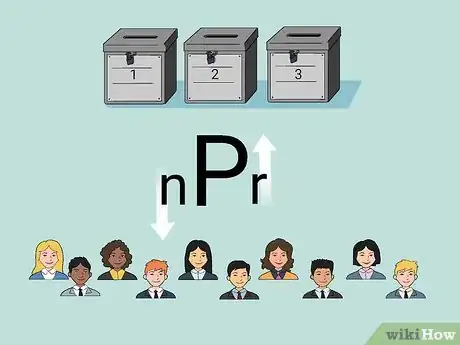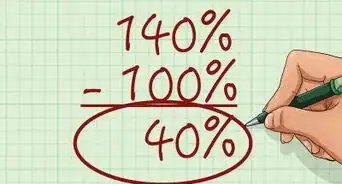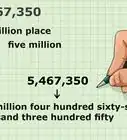wikiHow is a “wiki,” similar to Wikipedia, which means that many of our articles are co-written by multiple authors. To create this article, volunteer authors worked to edit and improve it over time.
There are 8 references cited in this article, which can be found at the bottom of the page.
This article has been viewed 49,356 times.
Learn more...
If you're working with combinatorics and probability, you may need to find the number of permutations possible for an ordered set of items. A permutation is an arrangement of objects in which the order is important[1] (unlike combinations, which are groups of items where order doesn't matter[2] ). You can use a simple mathematical formula to find the number of different possible ways to order the items. To start off, you just need to know whether repetition is allowed in your problem or not, and then pick your method and formula accordingly.
Steps
Calculating Permutations without Repetition
-
1Start with an example problem where you'll need a number of permutations without repetition. This kind of problem refers to a situation where order matters, but repetition is not allowed; once one of the options has been used once, it can't be used again (so your options are reduced each time).[3]
- For instance, you might be selecting 3 representatives for student government for 3 different positions from a set of 10 students. No student can be used in more than one position (no repetition), but the order still matters, since the student government positions are not interchangeable (a permutation where the first student is President is different from a permutation where they're Vice President).
- This kind of problem is often labeled as or , where is the number of total options you have to choose from and is how many items you need to choose.
-
2Know the formula: . In the formula, is the number of total options you have to choose from and is how many items you need to choose, where order matters and repetition is not allowed.
- In this example, would be the total number of students, so would be 10, and would be the number of people chosen, so would be 3.
Advertisement -
3Plug your numbers in for and .
- In this case you'd have .
-
4Solve the equation to find the number of permutations.
- If you have a calculator handy, find the factorial setting and use that to calculate the number of permutations. If you're using Google Calculator, click on the x! button each time after entering the necessary digits.
- If you have to solve by hand, remember that, for each factorial, you start with the main number given and then multiply it by the next smallest number, and so on until you get down to 0.
- For example, you would calculate 10! by doing (10 * 9 * 8 * 7 * 6 * 5 * 4 * 3 * 2 * 1), which gives you 3,628,800 as a result. 7! would be (7 * 6 * 5 * 4 * 3 * 2 * 1), which would equal 5,040. You'd then calculate 3,628,800/5,040.
- In the example, you should get 720. That number means that, if you're picking from 10 different students for 3 student government positions, where order matters and there is no repetition, there are 720 possibilities.
Calculating Permutations with Repetition
-
1Start with an example problem where you'll need a number of permutations where repetition is allowed.
- For example, if you have 10 digits to choose from for a combination lock with 6 numbers to enter, and you're allowed to repeat all the digits, you're looking to find the number of permutations with repetition.
- A permutation with repetition of n chosen elements is also known as an "n-tuple".[4]
-
2
-
3Plug in and .
- In the example, you'll get the equation .
-
4Solve for the number of permutations. If you have a calculator handy, this part is easy: Just hit 10 and then the exponent key (often marked xy or ^), and then hit 6.
- In the example, your answer would be . This means that, if you have a lock that requires the person to enter 6 different digits from a choice of 10 digits, and repetition is okay but order matters, there are 1,000,000 possible permutations.
Community Q&A
-
QuestionIs there an easy way in order to memorize the formula for this?
 WikiaWangTop AnswererYes. Think of it like this: subtract the total amount by the total items. For example 7 and 4. Then, find 7! to 4, so 7x6x5 and then find the answer, and you’ll get the permutations.
WikiaWangTop AnswererYes. Think of it like this: subtract the total amount by the total items. For example 7 and 4. Then, find 7! to 4, so 7x6x5 and then find the answer, and you’ll get the permutations.
References
- ↑ https://www.mathsisfun.com/combinatorics/combinations-permutations.html
- ↑ https://betterexplained.com/articles/easy-permutations-and-combinations/
- ↑ https://www.learneroo.com/modules/10/nodes/62
- ↑ https://en.wikipedia.org/wiki/Permutation#Permutations_with_repetition
- ↑ https://www.vitutor.com/statistics/combinatorics/permutations_repetition.html
- ↑ https://www.learneroo.com/modules/10/nodes/55
- ↑ https://mathbits.com/MathBits/TISection/Algebra1/Probability.htm
- https://www.mathsisfun.com/combinatorics/combinations-permutations-calculator.html





































































